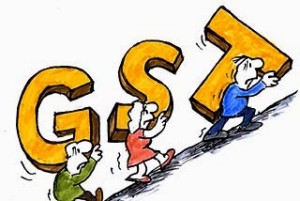The Rajya Sabha passed a bill to amend the Constitution that would facilitate the straitening of the Goods and Services Tax (GST) backing the government’s assurance that the tax rates would be kept “as low as possible”. It is noted that The Constitution (122nd Amendment) Bill, 2014 was approved by the Upper House with 203 votes in favor and none against and a rare affableness was witnessed among the ruling and the opposition parties of the central Government.
What is GST Bill?
The Goods and Services Tax Bill or GST Bill officially known as The Constitution (122 Amendment) Bill, 2014, proposes a national Value added Tax to be implemented in India with effect from June 2016.
- The GST Bill is aimed at bringing uniform tax regime in the country by subsuming state levies. Under it, a single rate of GST will replace Central Excise, State VAT, entertainment, entry and luxury taxes to ensure seamless transfer of goods and services.
- GST would be a comprehensive indirect tax on manufacture, sale and consumption of goods and services throughout India, to replace taxes levied by the Central and State governments.

- India being a federal republic GST would be implemented concurrently by the central government and by state governments.
- Goods and services tax would be levied and collected at each stage of sale or purchase of goods or services based on the input tax credit method. This method allows GST-registered businesses to claim tax credit to the value of GST they paid on purchase of goods or services as part of their normal commercial activity.
- Taxable goods and services are not distinguished from one another and are taxed at a single rate in a supply chain till the goods or services reach the consumer. Administrative responsibility would generally rest with a single authority to levy tax on goods and services.
- Exports would be zero-rated and imports would be levied the same taxes as domestic goods and services adhering to the destination principle.
- The introduction of Goods and Services Tax (GST) would be a significant step in the reform of indirect taxation in India. Amalgamating several Central and State taxes into a single tax would mitigate cascading or double taxation, facilitating a common national market.
- The simplicity of the tax should lead to easier administration and enforcement. From the consumer point of view, the biggest advantage would be in terms of a reduction in the overall tax burden on goods, which is currently estimated at 25%-30%
Latest Amendment:-
The Finance Minister Arun Jaitley proposed the GST which will enacts that presently 80% of goods attract 12.5% of Central excise duty while at the state level 55% of items are charged with 14.5% VAT or sales tax. The weighted average of the two in 65% of the items comes to 27%. Adding cess and entry tax takes the figure to 30%
- Then the President will constitute the GST Council which will draft the first GST Bill. It will be a recommendatory body with Finance Minister Arun Jaitley in the chair and shall include state government nominees and this body will determine the final rate and it is noted that the bill was passed by the Lok Sabha earlier.
- In sum, three enabling laws are required to be passed to give shape to the new tax regime — Central GST (CGST) and Integrated GST (IGST) that need to be cleared by Parliament, and 29 State GST legislations (SGST) that will have to be cleared by the respective state assemblies.
- It is a rare phenomenon that the major opposition party in the Parliament endorsed this GST bill amedndment following the six changes made in the bill, including scrapping of 1 per cent manufacturing tax and incorporates clearer provisions for compensating states for revenue loss for five years.
- Hopefully this GST bill should result in greater tax compliance, boosting government revenues. The GST will replace more than a dozen levies central and state levies, including central excise duty, service tax and central sales tax as well as VAT on sale of goods and entry tax, to make movement of goods seamless across 1.3 billion markets.






